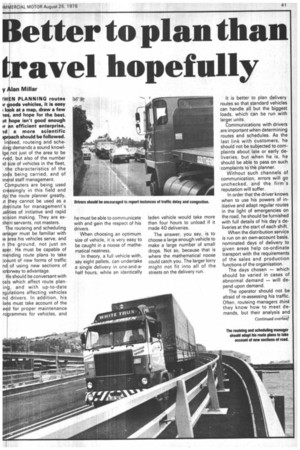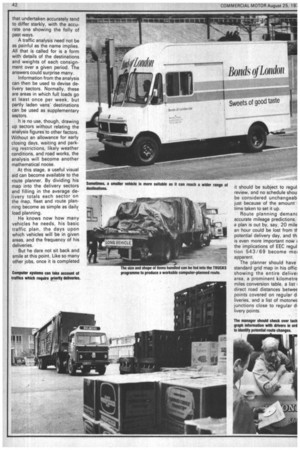etter to plan than ravel hopefully
Page 43

Page 44

Page 45

If you've noticed an error in this article please click here to report it so we can fix it.
V Ian Millar
IH N PLANNING routes or goods vehicles, it is easy 1
Iook at a map, draw a few le , and hope for the best. ut ope isn't good enough or n efficient enterprise, Id a more scientific lp ach should be followed. In eed, routeing and sche'lin demands a sound knowlIge not just of the area to be rv d, but also of the number id ize of vehicles in the fleet, I e characteristics of the )ci s being carried, and of
m ral staff management.
Crputasingly in this field and ers are being used cr .flp the route planner greatly, _ft hey cannot be used as a tb titute for management's Jai ties of initiative and rapid aci ion making. They are ex?.II nt servants, not masters. The routeing and scheduling ianager must be familiar with ie prea his vehicles serve, and n the ground, not just on ap r. He must be capable of mending route plans to take -_-,c .unt of new forms of traffic nd. of using new sections of iotorway to advantage. He should be conversant with osts which affect route plan
and with up-to-date lations affecting vehicles drivers. In addition, his s must take account of the d for proper maintenance rammes for vehicles, and he must be able to communicate with and gain the respect of his drivers.
When choosing an optimum size of vehicle, it is very easy to be caught in a noose of mathematical neatness.
In theory, a full vehicle with, say eight pallets, can undertake a single delivery in one-and-ahalf hours, while an identically laden vehicle would take more than four hours to unload if it made 40 deliveries.
The answer, you say, is to choose a large enough vehicle to make a large number of small drops. Not so, because that is where the mathematical noose could catch you. The larger lorry might not fit into all of the streets on the delivery run. It is better to plan delivery routes so that standard vehicles can handle all but the biggest loads, which can be run with larger units.
Communications with drivers are important when determining routes and schedules. As the last link with customers, he should not be subjected to complaints about late or early deliveries, but when he is, he should be able to pass on such complaints to the planner.
Without such channels of communication, errors will go unchecked, and the firm's reputation will suffer.
In order that the driver knows when to use his powers of initiative and adapt regular routes in the light of emergencies on the road, he should be furnished with full details of his day's deliveries at the start of each shift.
When the distribution service is run on an own-account basis, nominated days of delivery to given areas help co-ordinate transport with the requirements of the sales and production functions of the organisation.
The days chosen — which should be varied in cases of abnormal demand — will depend upon demand.
The operator should not be afraid of re-assessing his traffic, Often, routeing managers think they know how to meet demands, but their analysis and
that undertaken accurately tend to differ starkly, with the accurate one showing the folly of past ways.
A traffic analysis need not be as painful as the name implies. All that is called for is a form with details of the destinations and weights of each consignment over a given period. The answers could surprise many.
Information from the analysis can then be used to devise delivery Sectors. Normally, these are areas in which full loads go at least once per week, but partly laden vans' destinations can be used as supplementary swtors.
It is no use, though, drawing up sectors without relating the analysis figures to other factors. Without an allowance for early closing days, waiting and parking restrictions, likely weather conditions, and road works, the analysis will become another mathematical noose.
At this stage, a useful visual aid can become available to the route planner. By dividing his map into the delivery sectors and filling in the average delivery totals each sector on the map, fleet and route planning become as simple as daily load planning.
He knows now how many vehicles he needs, his basic traffic plan, the days upon which vehicles will be in given areas, and the frequency of his deliveries.
But he dare not sit back and smile at this point, Like so many other jobs, once it is completed it should be subject to regul review, and no schedule shou be considered unchangeab just because of the amount time taken to set it un.
Route planning demant accurate mileage predictions. a plan is out by, say, 20 mile an hour could be lost from ti potential delivery day, and th is even more important now I the implications of EEC regul tion 543/69 become moi apparent.
The planner should have standard grid map in his offic Showing the entire delivei area, a prominent kilometre miles conversion table, a list direct road distances betwee points covered on regular d liveries, and a list of motorwE junctions close to regular c11 livery points.
One further tool of route Inning is the tachograph, as est German operators told CM me years ago. Far from being 4arded as "spies in the cab," ay E re a helpful means of inpreting the effectiveness of istir g routes.
If a manager can read the aph he will identify persistent eas in which delays occur, d, ty spending time checking 'er the information with ivers, will be able often to iraft deliveries.
So often, drivers can be seen Tiing about ill-chosen routes
d can be heard crying out: uld have done better myself." idly their cries often go either iheard by management or anagers choose not to hear em. With proper tachograph alysis, they might have to. When a route planning sysrn is linked to an incentive nus scheme, the driver will be cou-aged to participate in its ccessful operation. If he sees at improvements, allowing for fety, will boost his weekly rnings, his observations about ikward routes will be voiced D re constructively and more eed ly.
Until recently, computerised vehicle scheduling sysrns have tended to fall into an .ictronic mathematical noose, r being too simple and lacking external influencing factors
e road system characteristics daily operational constraints. That may change with the ailability now of such systems the TRUCKS programme anrunced recently by Deltran )alysis Ltd.
By feeding in details of the laracteristics of goods to be rried (eg the size and shape of ims and the types of goods th which they must not be carried), the locations which will not accept split deliveries, and details of the roads to be used, TRUCKS can produce a workable schedule.
Deltran claims that the system's ability to produce realistic schedules can be proved by forcing it to reproduce a typical day's work which has taken place. By doing this, the model can be calibrated individually for each application.
Its programmes can be widened in complexity by introducing such factors as drivers' meal breaks, variable unloading times, and restrictions on maximum travel distances for some vehicles.
On a programme for interurban deliveries, factors introduced are vehicle speeds varying according to road type, certain locations which must be served first on a route, a mixing of trunk haulage and retail distribution, and a demand for a management information summary in addition to the work schedule,
TRUCKS can also be used to take account of priority locations which must receive same-day deliveries, and a rolling backlog of deliveries which causes the number of unserved points to grow.
With access to such electronic hardware and to the background knowledge of the entire process of routeing and scheduling, the operator will be able to maintain an efficient distribution service.
No longer can be shrug his shoulders and say: "'It has always been done this way."




































































































